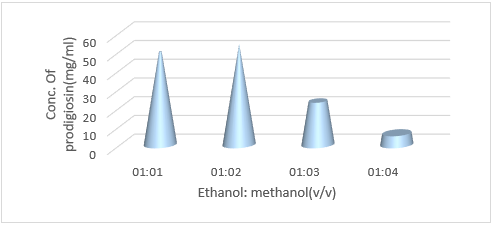Efficiency of Purified Prodigiosin Pigment from Serratia Marcescens as Bioremediator of Contaminated Soils and Burned Motor Oil with Hydrocarbons
Abstract
Serratia marcescens red pigment prodigiosin (PG) has been identified as a bioactive secondary metabolite that can be employed as a bioremediator. The prodigiosin red pigment was developed in several Serratia marcescens isolates from water. This pigment was extracted at higher quantities using a 1:2 (v/v) mixture of ethanol and methanol, yielding 53.8 mg/ml. The use of 100g/ml prodigiosin on contaminated soil improved the removal of hydrophobic pollutants (48%) from polluted soil more effectively than 150 mg/ml burned motor oil (32%. The proportion of hydrocarbon degradation was also increased by extending the incubation time, reaching 67 percent in polluted soils and 55 percent in burned motor oil after 96 hours, respectively. As a result, bioremediation with prodigiosin pigment has become a normal practice, as biological treatments are more efficient in eliminating waste and protecting natural resources, as well as being more cost-effective.
References
Maruthi, Y.M.; Hossain,K. and Sujata Thakre, S.(2013). Aspergillus flavus: A potential Bioremediator for oil contaminated soils. European Journal of Sustainable Development 2(1), 57-66.
Gomez, F.; Sartaj,M. (2013). Field scale ex-situ bioremediation of petroleum contaminated soil under cold climate conditions. International biodeterioration & biodegradation.85; 375-382.
Carbonell, G.V.; Colleta, D.; Yano, H.H.M.; Darini, T.; Levy, A.L.C. and Fonseca; B.A.L.(2000). Clinical relevance and virulence factors of pigmented Serratia marcescens. FEMS Immunol. Med. Microbiol. ;28 :143–149.
Montaner, B.; Navarro, S.; Piqué, M., Vilaseca, M., Martinell, M. Giralt, E., Gil, J., Peréz-Tómas, R.(2018). Prodigiosin from the supernatant of Serratia marcescens apoptosis in haematopoietic cancer cell lines. Br. J. Pharmacol.; 131: 585–593.
Stroud, J. L.; Paton, G. I. and Semple, K. T. (2007). Microbe-aliphatic hydrocarbon interactions in soil: implications for biodegradation and bioremediation. Journal of Applied Microbiology, 102(5):1239-1253.
Xixi Lia, Fuqiang Fana, Baiyu Zhanga, Kedong Zhangb, Bing Chen. (2018). Biosurfactant enhanced soil bioremediation of petroleum hydrocarbons: Design of experiments (DOE) based system optimization and phospholipid fatty acid (PLFA) based microbial community analysis. International Biodeterioration & Biodegradation.132: 216-225.
Fuentes, S.; Barra, B.; Caporaso, J.G. and Seegera, M. (2016). From rare to dominant: a fine-tuned soil bacterial bloom during petroleum hydrocarbon bioremediation. Applied and Environmental Microbiology. 82(3):888-96.
Gkorezis, P.; Daghio, M,; Franzetti, A.; Van Hamme, J.D.; Sillen, W. and Vangronsveld, J. (2016). The interaction between plants and bacteria in the remediation of petroleum hydrocarbons: an environmental perspective. Frontiers in microbiology. 7(1):33-39.
Ojuederie, O.B. and Babalola, O.O. (2017). Microbial and Plant-Assisted Bioremediation of Heavy Metal Polluted Environments: A Review. International journal of environmental research and public health. 14(12). 15-21.
Hardjito, L.; Huq, A. and Colwell, R.R.(2012). The influence of environmental conditions on the production of pigment by Serratia marcescens. Biotechnol. Bioprocess Eng.; 7:100–104.
Carbonell, G.V.; Della Colleta; H.H.M., Yano; T., Darini; A.L.C., Levy; C.E., Fonseca; B.A.L.(2000). Clinical relevance and virulence factors of pigmented Serratia marcescens. FEMS Immunol. Med. Microbiol. ; 28:143–149.
Montaner, B.; Navarro, S.; Piqué, M., Vilaseca, M., Martinell, M. Giralt, E., Gil, J., Peréz-Tómas, R.(2018). Prodigiosin from the supernatant of Serratia marcescens apoptosis in haematopoietic cancer cell lines. Br. J. Pharmacol.;131: 585–593.
Khanam, B. and Chandra, R. (2018). Comparative analysis of prodigiosin isolated from endophyte Serratia marcescens. Lett Appl Microbiol.; 66(3):194-201.
McFaddin, J.F. (2000). Biochemical Test for Identification of Medical Bacteria. 3rd. Ed. The Williams and Wilkins. Baltimore, USA.
Hardjito, L.; Huq, A. and Colwell, R.R.(2012). The influence of environmental conditions on the production of pigment by Serratia marcescens. Biotechnol. Bioprocess Eng.; 7:100–104.
Venil, C.K. and Lakshmanaperum, P. (2009). An insightful overview on microbial pigment, prodigiosin. Elect J. Biol., 5(3):49-61.
Gohil, N.; Bhattachariee, G. and Singh, V. (2020). Synergistic bactericidal profiling of prodigiosin extracted from Serratia marcescens in combination with antibiotics against pathogenic bacteria. Microb Pathog.; 149: 104508
mpfer, P.K. and Glaeser, S.P. (2016).Serratia aquatilis sp. nov., isolated from drinking water systems. International Journal of Systematic and Evolutionary Microbiology 66(1):11-15.
Lin, P.; Shen, J.; Ou, P.; Lin, L.; Chen, Z.; Chu, F.; Wang, J. and Jin, X.(). Prodigiosin isolated from Serratia marcescens in the Periplaneta americana gut and its apoptosis inducing activity in HeLa cells. Oncol Rep.,41(6):3377-3385.
Wei, Y. and Chen, W.(2005). Enhanced production of prodigiosin-like pigment from Serratia marcescens SMdelta R by medium improvement and oil-supplementation strategies. J. Biosci.Bioeng.; 99(6):616-22.
Shaba, A.M.; Oyeleke, S.B.; Oyewole, O.A.; Mohammed, S.S.D.; Salahudeen, A.O. and Ikekwem, C.C.(2017). Removal of lead and inhibition of algal growth using prodigiosin produced by serratia marcescens. Int. Res. J. Biological. Sci.; 6(8):1-6.







